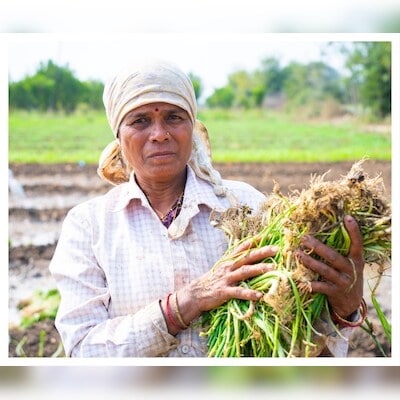These community-led initiatives are part of a broader pattern seen in a recent study of dietary diversity in rural India | Photo: Shutterstock
In the village of Pindwara in Rajasthan, a grassroots initiative led by local women has transformed the community’s approach to nutrition.
The women, part of a self-help group, began growing gardens to ensure a steady supply of diverse and nutritious food for their families.
These gardens now produce a variety of fruits and vegetables, contributing to a balanced diet and reducing the community’s dependence on market-bought foods, which are often less nutritious.
This initiative has not only improved health, but has also empowered women by giving them control over their family’s nutrition.
Similarly, in the tribal regions of Chhattisgarh, a collective effort by local community leaders has revitalized traditional farming practices.
The community has reintroduced indigenous crops such as millet and legumes, which are more resilient to climate change and require fewer resources to grow. These crops are rich in essential nutrients and have historically been part of the local diet.
Community efforts have not only preserved these traditional foods, but have also improved the nutritional status of the population, especially children and women.
These community-led initiatives are part of a broader pattern observed in a recent study of dietary diversity in rural India.
The qualitative study conducted by UNICEF-supported NGO Vitamin Angels India and conducted across several states found that communities with strong local leadership and grassroots initiatives showed significant improvements in dietary diversity and nutritional outcomes.
According to government data, approximately 17% of children aged 0-5 years are underweight, while 36% are stunted and 6% are wasted (too thin for their height, indicating acute malnutrition). Stunting, wasting and being underweight are key indicators of malnutrition in children aged 0-5 years.
The research highlighted that while government programs and interventions are essential, community participation and initiative are critical to the success and sustainability of these efforts.
One of the main conclusions of the study was that communities with active local participation in nutrition-related activities, such as gardening and growing traditional crops, had a higher intake of diverse and nutritious foods.
The research, which employed a combination of focus group discussions, in-depth interviews and household observations, reveals how collective and individual contexts – ranging from socio-cultural norms to economic challenges – influence the food practices of different communities, such as brick kiln workers, fishermen and salt workers, among others.
This was particularly evident in regions where women played a central role in these initiatives. The study also noted that these communities were more resilient to food insecurity and better prepared to face economic and environmental challenges.
For example, the study looked at the lives of salt workers in Jodhpur, who prioritize their children’s nutrition despite economic hardship. They make sure their children never go hungry, even if that means offering them biscuits or bread with milk.
He suggested that while government initiatives provide the necessary framework and resources, real change occurs when communities take ownership of these programs and adapt them to their local contexts.
To improve the effectiveness of nutritional interventions for pregnant women and children under five years of age, several key recommendations emerge from the study.
First, there is a critical need to strengthen the role of ASHA and Anganwadi workers, who are often the primary source of health information in many communities.
By providing these workers with advanced training that enables them to offer tailored advice based on the specific sociocultural and economic contexts of the families they serve, the reach and impact of nutrition programs can be significantly increased.
Subsidies for essential complementary foods are another vital measure to address the financial barriers faced by many families. These subsidies would ensure that even in economically disadvantaged households, children receive the necessary nutrients during crucial stages of development, the study recommended.
Furthermore, promoting a combination of traditional knowledge with modern nutritional knowledge can lead to more culturally acceptable and effective practices.
Health education programs that respect and incorporate local beliefs while introducing scientifically supported practices are more likely to be successful in achieving sustainable behavior change.
Supporting maternal health is also critical. Implementing programs that provide additional food or rest to pregnant women, particularly during the last trimester, can have a positive impact on maternal and child health.
These programs should be designed with local family structures and dynamics in mind, ensuring that they are accessible and acceptable within the community.
Community-based nutrition programmes should be developed to highlight the importance of child nutrition and encourage collective action. Workshops and information sessions led by trusted community members or health professionals can play a crucial role in disseminating knowledge and promoting healthy practices.
Finally, it is essential to improve access to fresh and nutritious food, particularly in remote or economically disadvantaged areas. This could involve initiatives such as creating community gardens, improving access to markets or providing transport subsidies to reach markets with a greater variety of foods.
(Only the headline and image of this report may have been reworked by Business Standard staff; the rest of the content is auto-generated from a syndicated feed.)
First published: August 11, 2024 | 14:12 IS
Disclaimer:
The information contained in this post is for general information purposes only. We make no representations or warranties of any kind, express or implied, about the completeness, accuracy, reliability, suitability or availability with respect to the website or the information, products, services, or related graphics contained on the post for any purpose.
We respect the intellectual property rights of content creators. If you are the owner of any material featured on our website and have concerns about its use, please contact us. We are committed to addressing any copyright issues promptly and will remove any material within 2 days of receiving a request from the rightful owner.

